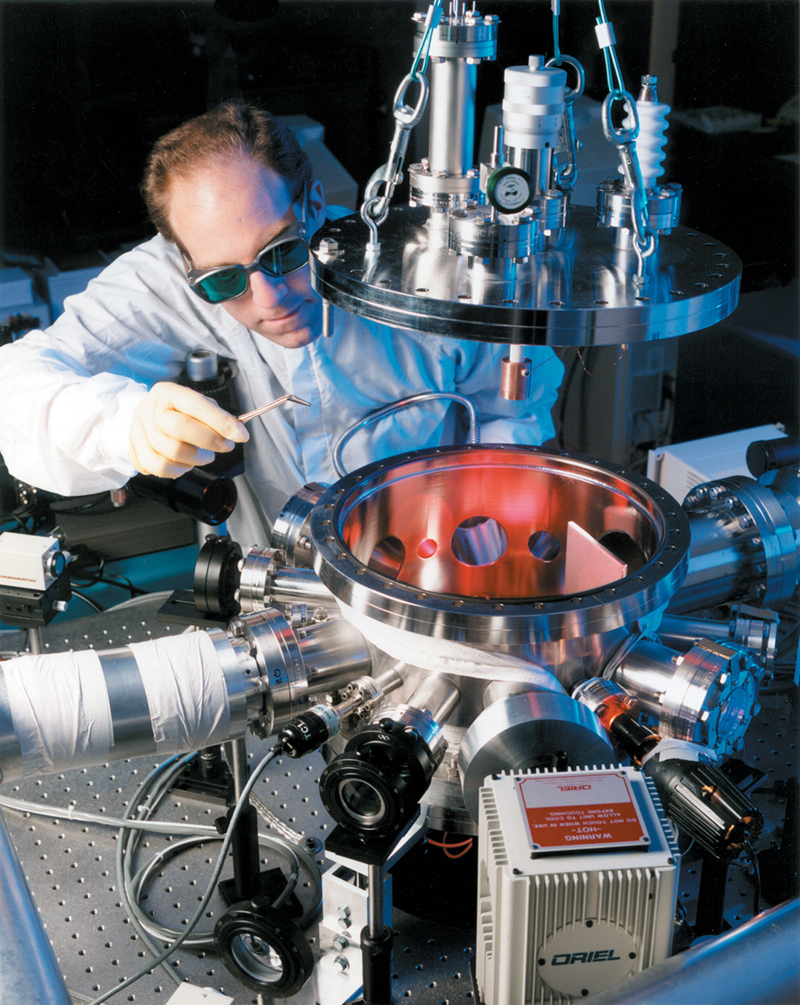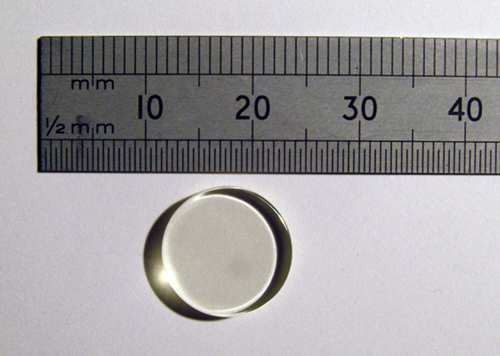
New Glass Serves as Window to Cutting-Edge Lasers
Originating Technology/ NASA Contribution
Since 1997, Marshall Space Flight Center’s Electrostatic Levitator (ESL) facility has been used to study the characteristics of new metals, ceramics, and glass compounds—in both their hot molten states and as they are cooled to form solid materials. The ESL provides a unique way to test such substances without having to make contact with a container or crucible that would contaminate the sample. Simply put, objects analyzed in the levitator’s chamber float in mid-air with no visible means of support or containment, suspended only by static electricity. While a sample object is levitated, a laser beam heats it until it melts so that scientists can measure its physical properties without interference from a container.
Materials created as a result of the ESL tests include new optics, spacecraft components, and space-age alloys that have yielded longer-hitting, “liquid metal” golf clubs. One of the most recent creations to come from the levitator is a revolutionary family of glasses now being manufactured and sold by Containerless Research, Inc., of Evanston, Illinois.
Partnership
NASA’s Research Announcement (NRA) program invites private corporations, research institutes, and universities to submit proposals for research projects on Earth and in space. Containerless Research received an NRA grant for a proposed International Space Station flight experiment to investigate liquid-liquid phase separation effects in deeply undercooled oxide liquids. The resulting research—also supported by the National Science Foundation and the U.S. Air Force Office of Scientific Research—involved the utilization of various types of containerless processing technology, including NASA’s ESL, and ultimately led to Containerless Research’s invention of Rare Earth Aluminum oxide (REAl™) Glass materials.
Product Outcome
Made from rare Earth oxides, aluminum oxide, and trace amounts of silicon dioxide, REAl Glass is currently available for laser, infrared, and optical communications applications as a low-cost alternative to expensive optical glasses, gain media, and crystals. REAl Glass is generated from a “supercooled” liquid, meaning that a liquid is cooled quickly enough to prevent its atoms from organizing and forming a crystal structure (at room temperature and lower temperatures, the atoms are “trapped” in this jumbled, glassy state). The new patented innovation enables higher power densities, more efficient laser power conversion, broader spectral bandwidths, and increased infrared transmission when compared to the likes of other materials, such as conventional crystalline sapphire. Containerless Research is developing larger scale processing of the glass, and its goal is to offer products in a variety of forms, including rods and plates that are tailored to specific applications.
Containerless Research is establishing a niche-market for REAl Glass in the high-power laser field by giving lasers more power and much less heat dissipation. Whether it is an industrial power laser for cutting car bodies or a medical laser used for surgery, the “heart” of a laser is the “gain medium,” which is where REAl Glass can be applied. This critical component increases or amplifies light, resulting in an intense, highly concentrated beam capable of precisely cutting metal parts or surgically removing or repairing human tissue. A more efficient gain medium allows for a more compact laser system that can operate at a lower power level while providing the same output power, thus giving laser manufacturers a broader range of choices in designing lasers.
“Most surgical lasers now use expensive single crystals, which limit the range of operating wavelength to very narrow bands,” explains Dr. Richard Weber, director of Containerless Research’s Glass Products Division. “REAl Glass provides the additional advantage of tunability, which can give more control over surgical procedures, an important factor in different types of surgery and for different skin types. Our glass can provide efficient power lasers and expand coverage to new wavelengths.” The ability to tune the light wavelength could also have important implications for any lasers used in dental procedures.
REAl Glass also offers a medium for next-generation optical communications devices that need to be small, low-cost, and powerful enough to provide fiber for business andbroadband Internet connections. For example, the new glass innovation could cut back the size and weight of certain telecommunications components that are used in supplying fiber to the home, thus making room for smaller, inexpensive broadband amplifiers. Containerless Research has developed the capability to customize the glass composition for such communications applications.
Additionally, because REAl Glass possesses outstanding environmental capabilities and “moldability,” a multitude of military and homeland security applications are on the horizon, including low-dispersion lenses and infrared windows, as well as technology that could possibly be used to help detect explosives and toxins and confuse heat- seeking missiles.
Marshall Space Flight Center’s ESL facility is supported by NASA’s Microgravity Materials Science Research Project Office, a division of NASA’s Office of Biological and Physical Research (OBPR). OBPR conducts interdisciplinary, peer-reviewed, fundamental, and applied research to address the opportunities and challenges to NASA that are provided by the space environment and the human exploration of space.
REAl™ is a trademark of Containerless Research, Inc.

Containerless Research, Inc., can cast its REAl glass in a variety of shapes (disk shown here) needed for different applications, including surgical lasers and power lasers used to cut metal.

A microgravity researcher works with the Electrostatic Levitator, which uses static electricity to suspend a sample object inside a vacuum chamber while a laser heats the object until it melts. This lets scientists record a wide range of physical properties without the sample contacting the container or any instruments, thus eliminating conditions that would alter the readings. Such “containerless” experiments have led to a new family of glasses.













